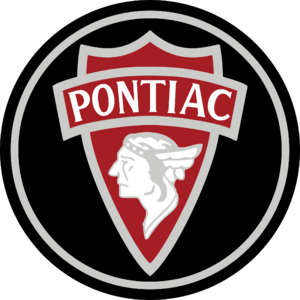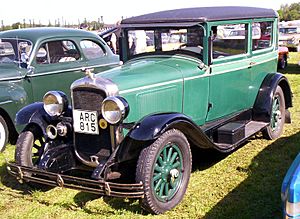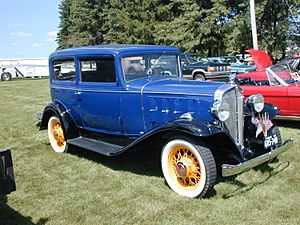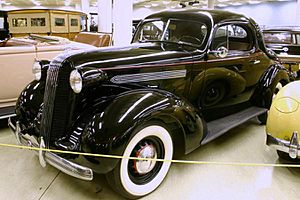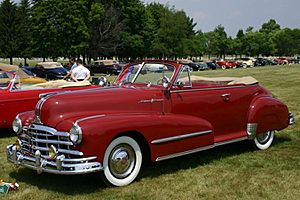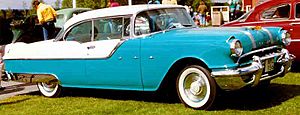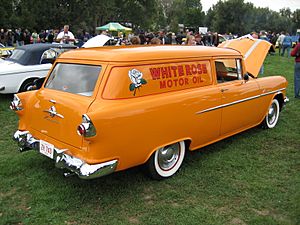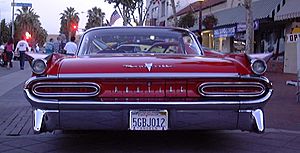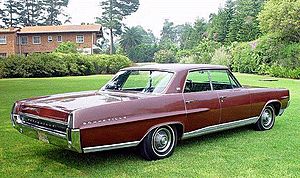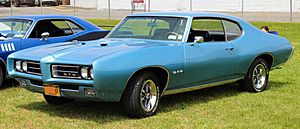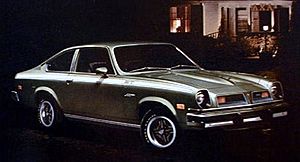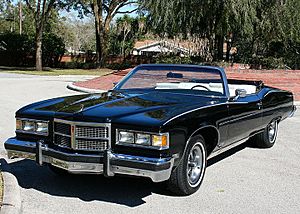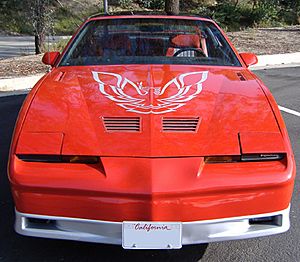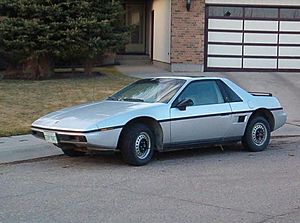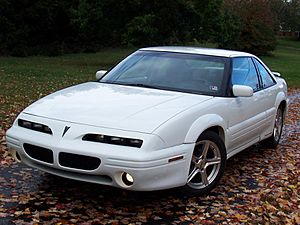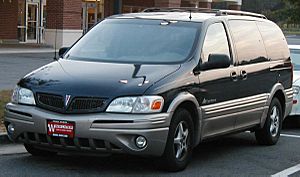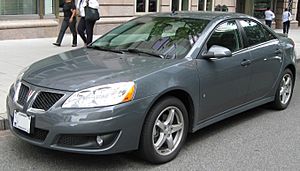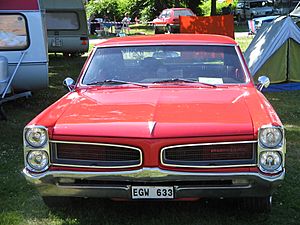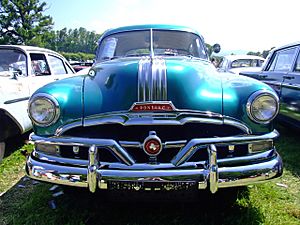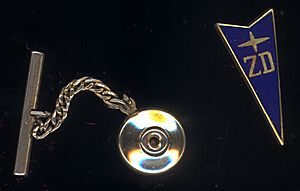Pontiac (automobile) facts for kids
 |
|
| Brand (1926–1931) Division (1931–2010) |
|
| Industry | Automotive |
| Fate | Cut off upon General Motors Chapter 11 reorganization |
| Founded | 1926; 84 years ago |
| Founder | General Motors |
| Defunct | October 31, 2010; 12 years ago |
| Headquarters | Detroit, Michigan, United States |
|
Area served
|
Canada, United States, Mexico, Puerto Rico, U.S. Virgin Islands, Middle East |
|
Key people
|
Frank Hershey Irving Jacob Reuter Semon "Bunkie" Knudsen John Z. DeLorean |
| Products | Automobiles |
| Parent | Oakland Motor Car (1925–1931) General Motors (1931–2010) |
Pontiac was a famous American car brand. It was owned and made by General Motors (GM). Pontiac started in 1926 as a cheaper car line for GM's more expensive Oakland cars.
Soon, Pontiac became more popular than Oakland. By 1933, Pontiac had completely replaced the Oakland brand. Pontiac cars were sold in the United States, Canada, and Mexico. Within GM, Pontiac was placed above Chevrolet but below Oldsmobile, Buick, and Cadillac.
Starting in 1959, Pontiac focused on selling a cool lifestyle, not just the car. They called themselves the "performance division" of General Motors. Their slogan was "we build excitement."
Due to money problems, GM announced in 2008 that Pontiac would stop making cars. The last Pontiac cars were built in late 2009 and early 2010. By October 31, 2010, the Pontiac brand was officially gone. GM then focused on its four main North American brands: Chevrolet, Buick, Cadillac, and GMC.
Contents
History of Pontiac Cars
Early Years: 1926–1942
The Oakland Motor Car Company started in 1907 in Pontiac, Michigan. In 1909, Oakland became part of General Motors. In 1926, the first Pontiac car, the Pontiac Series 6-27, was introduced. It had a six-cylinder engine and was meant to be a more affordable option than Oakland cars.
Pontiac was named after a famous Odawa chief. The city where the cars were made, Pontiac, Michigan, was also named after him. Pontiac cars quickly became very popular. They sold much better than Oakland cars. Because of this, Pontiac became its own division of GM when Oakland stopped making cars in 1931.
Pontiac cars were also built in Japan from 1927 to 1941. This was done using "knock-down kits," which are car parts shipped to be put together in another country.
Early Pontiacs had special features. The 1927 Pontiac Series 6-27 had a unique six-cylinder engine. It sold over 76,000 cars in its first year. By 1928, it was the best-selling six-cylinder car in the U.S. When the Wall Street Crash of 1929 happened, car sales dropped. But because Pontiac was more affordable, GM decided to keep it.
In 1932, Pontiac introduced a V8 engine. However, they soon switched to a straight-eight engine for 1933. This engine was used until 1954. Pontiac cars with straight-eight engines were the cheapest available at the time. They shared parts with Chevrolet cars to save money. Pontiacs from this era had a shiny chrome strip on the hood called the "Silver Streak."
In 1935, Pontiac cars started looking more modern. They shared a sleek "torpedo" body style with other GM brands. At the 1939 New York World's Fair, a special 1939 Pontiac Deluxe Six was shown. It had clear plastic body panels so people could see inside!
By 1942, all car factories in the U.S. switched to making military equipment. So, Pontiac stopped making cars for regular people during World War II.
After the War: 1946–1954
After World War II, Pontiac cars from 1946 to 1948 were similar to the 1942 models. In 1948, the Hydramatic automatic transmission was added. This helped Pontiac sell more cars.
In 1949, Pontiac introduced completely new car designs. The Chieftain line replaced the older Torpedo models. In 1950, the Catalina hardtop coupe was launched. This was a special "halo" model, meaning it was designed to attract attention to the brand.
By 1952, the Streamliner model was stopped. In 1954, the Star Chief was added. It was a longer car, built on a stretched platform. Pontiac had planned to introduce a V8 engine in 1953. But another GM brand, Buick, was launching its own new V8. So, Pontiac's V8 was delayed.
The V8 Era and "Wide Track": 1955–1960
In 1955, Pontiac introduced completely new car bodies and frames. Sales went up! A new Strato Streak V8 engine was also launched. This meant Pontiac stopped making six-cylinder engines for its full-size cars for a long time.
In 1956, Semon "Bunkie" Knudsen became the head of Pontiac. He wanted to change Pontiac's image. One of the first things he did was remove the "silver streaks" from the cars. These had been a traditional Pontiac design since 1933. The first Bonneville car was also introduced. It was a special version of the Star Chief.
In 1958, the Bonneville became its own car line. A 1958 Bonneville was the pace car for the Indianapolis 500 race. This was also the last year for the "Indian" design theme on most of the car.
For 1959, Pontiac introduced its famous "Arrowhead" emblem. This design went up the hood from the split grille. Knudsen also made sure Pontiacs got completely new bodies and interiors. The cars became longer and lower.
The Chieftain line was renamed Catalina. The Bonneville became the top-of-the-line model. All 1959 Pontiacs had a powerful V8 engine. Motor Trend magazine chose the Pontiac line as the "Car of the Year" for 1959. These 1959 models were also known for their "Wide-Track" design. This meant the wheels were set wider apart, which made the cars look better and handle better.
The 1960 models got a new look, but they kept the same body shape as the 1959s. They removed the tail fins and the split grille. The Ventura model was introduced. It was a more luxurious car, placed between the Catalina and Star Chief models.
Performance Era: 1961–1970
During the 1960s, many Pontiac models shared their basic shape with other GM cars. However, Pontiac kept its own unique front and rear designs, interiors, and engines.
In 1961, Pontiac cars were restyled again. The split grille returned. All full-size models got a new frame design. A new compact car, the Tempest, was also introduced. It was one of three new compact cars from GM that year. The Tempest even won the Motor Trend "Car of the Year" award in 1961. Later in 1961, a fancier version of the Tempest called the LeMans was launched.
The Tempest had a unique four-cylinder engine. For 1963, Pontiac offered a new V8 engine in the Tempest. More than half of the Tempests and LeMans cars that year were ordered with the V8. The Tempest's popularity helped Pontiac become the third best-selling American car brand in 1962. Pontiac held this position until 1970.
In 1962, Pontiac introduced the Grand Prix. It was a sportier coupe with bucket seats. Even though GM officially stopped supporting racing in 1963, Pontiac continued to make larger, more powerful engines.
In 1964, the Tempest and LeMans cars were redesigned. They got a more traditional car frame. This year also saw the introduction of the famous GTO. The GTO was offered as a special package for the LeMans. It included a powerful 389 cubic inch engine. This made the GTO one of the first "muscle cars."
The entire Pontiac lineup was chosen as Motor Trend's Car of the Year for 1965. This was the third time Pontiac received this award. In 1966, Pontiac introduced a new type of six-cylinder engine. It was one of the first mass-produced engines with an overhead camshaft in a popular American car.
The 1967 model year brought the Pontiac Firebird pony car. It was similar to the Chevrolet Camaro. Intermediate-sized cars got a new look. Full-size cars and the GTO got a larger 400 cubic inch V8 engine.
In 1968, the GTO introduced a special "rubber" front bumper. This was an early version of the integrated bumpers we see on modern cars. Pontiac also introduced "Ram Air" engines. These engines took in cold air to make more power.
For 1969, the Grand Prix became its own special luxury car. It had a long hood and short back. This new Grand Prix was a huge success, selling over four times more cars than the 1968 model. Full-size Pontiacs were also restyled. The GTO and Firebird models got the Ram Air option. The GTO also got the "Judge" performance package. The Firebird got the "Trans Am" package.
Pontiac cars built in the late 1960s had new safety features. These included energy-absorbing parts inside the car, dual brake systems, seat belts, and headrests.
Changes and Challenges: 1970–1982
Rising insurance costs and fuel prices made powerful muscle cars less popular. New government rules for emissions and safety also changed car designs. Safety, luxury, and fuel economy became more important. Engine performance started to decline in 1971. This was because GM required all engines to use lower-octane unleaded gasoline.
In 1971, Pontiac introduced the compact Ventura II. This car was based on the Chevrolet Nova. Pontiac also completely restyled its full-size cars. The Grand Ville became a more luxurious model. Station wagons had a new "clamshell" tailgate. The rear window slid into the roof, and the tailgate dropped below the floor.
The 1972 models had more emissions controls and safety updates. The GTO became a sub-model of the LeMans. The Tempest was discontinued.
For 1973, Pontiac restyled its Grand Prix, LeMans, and Ventura models. They also introduced the new Grand Am. Engine power continued to drop due to more emissions rules. The 1973 Firebird Trans Am had a huge bird decal on its hood. A very powerful "Super Duty 455" engine was introduced. It was available in some Firebird Trans Ams and was considered one of the last truly fast cars of that era.
By 1975, Pontiac introduced the new sub-compact Astre. This car was a version of the Chevrolet Vega. It was Pontiac's entry into the fuel-efficient car market. 1975 was also the last year for Pontiac convertibles for a decade.
The 1976 models were the last of the traditional large American cars. After this year, all GM cars became smaller and lighter. The 1976 Sunbird was added. It was based on the Chevrolet Vega.
In 1977, Pontiac introduced the Phoenix, a fancier version of the Ventura. Pontiac also launched its "Iron Duke" four-cylinder engine. This engine was used in many GM cars into the 1990s. The Iron Duke and the 301 cubic inch V8 were the last engines designed only by Pontiac. After this, all GM brands shared engine designs.
The full-size Pontiacs were "downsized" in 1977. The new Bonnevilles and Catalinas continued to sell well. In 1981, the full-size Bonneville was discontinued. Its name was given to a smaller car.
The late 1970s and early 1980s focused on luxury, safety, and fuel economy. More station wagons were offered. Rear-wheel drive cars slowly started to disappear. The first front-wheel drive Pontiac, the 1980 Phoenix, was introduced.
The Firebird became very popular thanks to movies like 'Smokey and the Bandit' and TV shows like 'The Rockford Files'. The Firebird was available with special Formula and Trans Am packages. For 1980 and 1981, it even had a turbocharged V8 engine.
New Designs and Focus: 1982–1988
In 1982, the Firebird got a major new design. It was featured in the TV series Knight Rider, which made it very famous. Pontiac started making more performance-focused cars. A convertible Firebird was brought back after nine years. The new 1982 J2000 (later called Sunbird) also had a convertible model.
The 1984 Fiero was a completely new type of car for Pontiac. It was a two-seat, mid-engined sports car. The Fiero helped Pontiac's sales increase for the first time in four years. Pontiac also started focusing on technology. In 1984, a Special Touring Edition (STE) was added to the 6000 line. It had digital instruments and other electronics.
Pontiac also sold the Parisienne, which was a slightly changed Caprice. This car sold well in Canada and continued until 1986 for sedans and 1989 for station wagons.
By 1988, most Pontiac cars, except for the Firebird and Fiero, switched to front-wheel drive. For the first time since 1970, Pontiac was the third largest American car maker. The average age of Pontiac owners also dropped, showing that younger people were buying their cars.
Modern Era: 1989–1997
New features were added to Pontiacs in this period. These included anti-lock brakes, airbags, and new engines. The Safari station wagon stopped production in 1989. It was the last V8-powered, rear-wheel drive full-size Pontiac until 2009.
In 1990, Pontiac launched its first minivan, the Trans Sport. The Grand Prix line also added its first-ever 4-door model. By the end of 1991, the 6000 model was discontinued.
In 1992, a brand-new Bonneville was introduced. This full-size car had a sleek, aerodynamic design and front-wheel drive. A new, powerful SSEi model was added, with a supercharged V6 engine.
A completely new Firebird was introduced in 1993. It had a V6 engine or a powerful LT-1 V8 engine. The Sunbird was replaced by the Sunfire in 1995. For 1996, the Bonneville got updated looks and more powerful engines.
Division Sales Figures
| Year | Sales |
|---|---|
| 1989 | 801,600 |
| 1990 | 636,390 |
| 1991 | 518,598 |
| 1992 | 519,925 |
| 1993 | 533,776 |
| 1994 | 577,022 |
| 1995 | 589,192 |
| 1996 | 479,973 |
| 1997 | 563,897 |
New Models and End of Production: 1997–2010
The Grand Prix was redesigned in 1997 with the slogan "Wider is Better." A powerful GTP model was added. In 1998, the Firebird was updated. The TransAm model got a powerful LS-1 engine. In 1999, the Trans Sport minivan was replaced by the larger Montana.
In 2000, the Bonneville got a major new design. In 2001, Pontiac introduced the Aztek, an early SUV.
In 2002, both the Firebird/Trans Am and Camaro were discontinued. This was due to lower sales. The coupe version of the Grand Prix was also stopped. The 2003 Vibe arrived in 2002. It was a compact wagon based on a Toyota car. 2003 was also Pontiac's last year in NASCAR racing.
2004 saw the return of the Pontiac GTO. It was based on an Australian car called the Holden Monaro. The GTO had a powerful V8 engine and a fancy leather interior. For 2005 and 2006, the GTO got an even more powerful LS2 V8 engine. The Bonneville introduced the GXP model, which had a V8 engine from Cadillac. The redesigned Grand Prix also appeared, with a more powerful supercharged V6 engine.
With the discontinuation of Oldsmobile in 2004, Pontiac started to change its product lineup. The Grand Am was replaced by the mid-size G6 in 2005. The Bonneville stopped production in 2005 after almost 50 years. The Solstice sports car was approved for production in 2006. It was made as a roadster (convertible) and a few coupes. The Aztek was replaced by the Torrent, which was similar to the Chevrolet Equinox.
In 2005, the Sunfire was replaced by the new Pontiac Pursuit (later called G5 in the U.S.). The high-performance GXP trim was added to the Grand Prix line in 2005. It had a powerful V8 engine. In 2008, the Grand Prix stopped production. The Australian-built, rear-wheel drive G8 was launched. The G8 was praised for its high performance and lower cost. Many people called it the "poor man's BMW M5." The G8 GXP was the most powerful production car Pontiac ever built.
On December 2, 2008, General Motors announced it was thinking about getting rid of several brands, including Pontiac. This was to help GM get a large loan. By April 2009, reports said GM would drop the Pontiac brand. On April 27, 2009, GM officially announced that Pontiac would be phased out by the end of 2010. GM decided to focus on Chevrolet, Buick, GMC, and Cadillac.
Some people tried to buy the Pontiac brand, but GM had already decided to retire it. The last Pontiac car, a white 2010 G6 sedan, was built in January 2010. Pontiac was one of three brands GM stopped making in 2010. The others were Hummer and Saturn.
Pontiac's Style and Logos
Pontiac used a Native American headdress as its logo until 1956. In 1957, this was changed to a red arrowhead design. This arrowhead logo is also known as the "Dart."
Another famous Pontiac style was the "Silver Streaks." These were thin strips of shiny stainless steel that ran down the middle of the hood. Later, they also ran from the rear window to the bumper. These streaks were stopped in 1957, the same year as the Indian Head emblems.
A long-standing design feature was the "split-grille." This design was introduced in 1959 to match the cars' new "wide track" look. The 1960 models went back to a full-width grille. But the split grille returned in 1961 and became a Pontiac trademark. Other style cues included a pointed "arrowhead" nose and taillights with multiple horizontal stripes.
In the 1990s and 2000s, many Pontiacs had "cladding" on their doors and fenders. This was a unique design where the side bumpers were very noticeable. From 2004 onwards, new Pontiacs had a cleaner, more modern look, but they still kept the traditional split grille.
Canadian and Export Models
Pontiac cars were also built in Canada by GM Canada starting in 1926. These cars were mostly the same as the U.S. models. However, Canadian cars often used different engines. For example, after 1940, a Canadian-built six-cylinder engine was used. Canadian Pontiacs also shared chassis and body parts with Chevrolets to save money.
After World War II, Pontiac remained very popular in Canada. The Canadian Pontiacs were often built on Chevrolet chassis with Chevrolet engines. This was because Canadian dealerships were set up differently. It was important to keep Pontiac prices competitive with other brands like Plymouth and Ford.
GM Canada also built right-hand drive Pontiacs. These were sent as "knock-down kits" to countries like Australia, New Zealand, and South Africa. These cars were put together there.
Even after trade agreements made it easier to import cars, the practice of building Pontiac-badged Chevrolets for sale in Canada continued. Examples include the Astre (based on the Vega) and the Firefly (based on the Sprint). This continued until the Pontiac brand was stopped in 2010.
Engines Used in Pontiac Cars
A Pontiac engineer named Clayton Leach designed a special part for engines called the stamped steel valvetrain rocker arm. This simple and reliable design was later used by many other engine makers.
Pontiac started working on a V8 engine in 1946. It was supposed to be introduced in 1953. But another GM division, Buick, was launching its new V8 engine that year. So, Pontiac's V8 was delayed until the 1955 model year.
In 1956, Pontiac introduced a more powerful version of its V8 engine. This engine had special parts for racing and multiple carburetors. This helped Pontiac become a big player in the muscle car era of the 1960s.
Pontiac's second-generation V8 engines, made from 1959 to 1979, were very similar. Many parts could be swapped between them. This made it easier to rebuild these engines. This similarity also helped Pontiac create the modern muscle car. They simply put their second-largest engine, the 389 cubic inch V8, into their mid-size Le Mans car. This created the famous Pontiac LeMans GTO.
From the 1950s to the early 1970s, Pontiac engines were known for their power. The 455 cubic inch V8 was the largest and most powerful. At its peak, Pontiac engines could produce up to 390 horsepower. However, new emissions laws caused engine power to decline. One exception was the Super Duty 455 engine from 1973–1974. It was available only in the Firebird Formula and Trans Am models. This engine was very powerful and had some features from racing engines.
The only Pontiac V8 engines that were very different were the 301 and 265 cubic inch versions. These were made from 1977 to 1981. They were the last V8s made by Pontiac. After 1980, GM combined all its brands' engine designs into one group.
Pontiac engines were not available in Canada. Instead, Canadian Pontiacs used Chevrolet engines of similar size and power.
Carburetors
Pontiac used different types of carburetors over the years. Early V8 engines mostly used 2-barrel carburetors. These were also the basis for the "Tri-Power" setups.
The Tri-Power setup had one main carburetor and two extra ones. The extra carburetors only started working when the driver pressed the gas pedal more than halfway down. This gave the car a boost of power. Tri-Power was a factory option from 1957 to 1966.
Pontiac also used a 4-barrel carburetor. Later, they used the "Quadrajet" carburetor. This was a "spread-bore" design. It had smaller openings for normal driving and larger openings for more power. This design helped the engines get more airflow.
By the end of the muscle car era, the Quadrajet was common on Pontiac engines. This design continued to be used for many years, with computer controls added to meet emissions and fuel economy rules.
Models
- Pontiac 2+2 (1964–1970)
- Pontiac 1000 (1983–1987)
- Pontiac 2000 (1983)
- Pontiac 2000 Sunbird (1983–1984)
- Pontiac 6000 (1982–1991)
- Pontiac Acadian (1976–1987, Canada)
- Pontiac Astre (1975–1977; 1973–1977 Canada)
- Pontiac Aztek (2001–2005)
- Pontiac Bonneville (1957–2005)
- Pontiac Catalina (1959–1981)
- Pontiac Chieftain (1949–1958)
- Pontiac Custom S (1969)
- Pontiac De-Lux (1937)
- Pontiac Executive (1967–1970)
- Pontiac Fiero (1984–1988)
- Pontiac Firebird (1967–2002)
- Pontiac Firefly (1985–2001, Canada)
- Pontiac G3 (2006–2009 (Mexico), 2009 (US))
- Pontiac G4 (2005–2009, Mexico)
- Pontiac G5 (2007–2009)
- Pontiac G6 (2004–2010)
- Pontiac G8 (2008–2009)
- Pontiac GT-37 (1970-1971)
- Pontiac Grand Am (1973–1975, 1978–1980, 1985–2005)
- Pontiac Grand Prix (1962–2008)
- Pontiac Grand Safari (1971–1978)
- Pontiac Grand Ville (1971–1975)
- Pontiac Grande Parisienne (1966–1969, Canada)
- Pontiac GTO (1964–1974, 2004-2006)
- Pontiac J2000 (1982)
- Pontiac Laurentian (1955–1981, Canada)
- Pontiac LeMans (1962–1981, 1988–1993)
- Pontiac Matiz (1998–2005, Mexico)
- Pontiac Matiz G2 (2006–2010, Mexico)
- Pontiac Montana (1999–2005)
- Pontiac Montana SV6 (2005–2006, continued in production for Canada and Mexico until 2009)
- Pontiac Parisienne (1983–1986; 1958–1986, Canada)
- Pontiac Pathfinder (1955–1958, Canada)
- Pontiac Phoenix (1977–1984)
- Pontiac Pursuit (later G5 Pursuit) (2005–2006, Canada)
- Pontiac Safari (1955–1989)
- Pontiac Silver Streak
- Pontiac Solstice (2006–2009)
- Pontiac Star Chief (1954–1966)
- Pontiac Star Chief Executive (1966)
- Pontiac Strato-Chief (1955–1970, Canada)
- Pontiac Streamliner (1942-1951)
- Pontiac Sunbird (1975–1980, 1985–1994)
- Pontiac Sunburst (1985–1989, Canada)
- Pontiac Sunfire (1995–2005)
- Pontiac Sunrunner (1994–1997, Canada)
- Pontiac Super Chief (1957–1958)
- Pontiac T1000 (1981–1982)
- Pontiac T-37 (1970-1971)
- Pontiac Tojan (1985 -1991)
- Pontiac Tempest (1961–1970; 1987–1991, Canada)
- Pontiac Torpedo (1940-1948)
- Pontiac Torrent (2006–2009)
- Pontiac Trans Am (1969–2002)
- Pontiac Trans Sport (1990–1998)
- Pontiac Ventura (1960–1970 full-size, 1973–1977 compact)
- Pontiac Ventura II (1971–1972)
- Pontiac Vibe (2003–2010)
- Pontiac Wave (later G3 Wave) (2004–2010, Canada)
Evolution of Models
See also
 In Spanish: Pontiac para niños
In Spanish: Pontiac para niños
- Category:Pontiac vehicles
- Pontiac V8 engine
- Pontiac Straight-8 engine
- Pontiac Straight-6 engine
- List of GM engines
- Pontiac, Michigan
- Pontiac (person)


